Installing a CRS
Follow the instructions provided by the manufacturer when installing the child seat. Note these general steps when installing the seat to your vehicle:
-
Properly secure the child restraint to the vehicle. All child restraints must be secured to the vehicle with the lap part of a lap/shoulder belt or with the LATCH system.
-
Make sure the child restraint is firmly secured. After installing a child restraint to the vehicle, push and pull the seat forward and from side-to-side to verify that it is securely attached to the seat. A child restraint secured with a seat belt should be installed as firmly as possible. However, some side-to-side movement can be expected.
-
Secure the child in the child restraint. Make sure the child is properly strapped in the child restraint according to the manufacturer instructions.
Lower Anchors and Tether for Children (LATCH) system
The LATCH system holds a child restraint during driving and in an accident. This system is designed to make installation of the child restraint easier and reduce the possibility of improperly installing your child restraint. The LATCH system uses anchors in the vehicle and attachments on the child restraint. The LATCH system eliminates the need to use seat belts to secure the child restraint to the rear seats.
Lower anchors are metal bars built into the vehicle. There are two lower anchors for each LATCH seating position that will accommodate a child restraint with lower attachments.
To use the LATCH system in your vehicle, you must have a child restraint with LATCH attachments.
The child seat manufacturer will provide you with instructions on how to use the child seat with its attachments for the LATCH lower anchors.
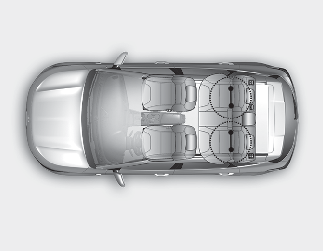
LATCH anchors have been provided in the left and right outboard rear seating positions. Their locations are shown in the illustration. There are no LATCH anchors provided for the center rear seating position.

LATCH Lower Anchors
Never attempt to attach a LATCH equipped seat in the center seating position. LATCH lower anchors are only to be used in the left and right rear outboard seating positions. You may damage the anchors or the anchors may fail and break in a collision if the seat is in the center seating position.
The lower anchor position indicator symbols are located on the left and right rear seatbacks to identify the position of the lower anchors in your vehicle (see arrows in illustration).
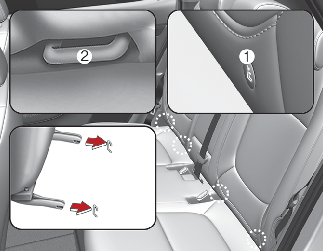
-
Lower Anchor position indicator
-
Lower Anchor
The LATCH anchors are located between the seatback and the seat cushion of the rear seat left and right outboard seating positions.
To use the lower anchor, push the upper portion of the lower anchor cover.
Securing a child restraint with the LATCH anchors system
To install a LATCH-compatible child restraint in either of the rear outboard seating positions:

Take the following precautions when using the LATCH system:
-
Read and follow all installation instructions provided with your Child Restraint System.
-
To prevent the child from reaching and taking hold of the unused seat belts, buckle all unused rear seat belts before the child is placed into the vehicle. Lock each unused seatbelt following the instructions in the "automatic locking mode" subsection, and place the webbing behind the child seat or against an unused seatback. Children can be strangled if a shoulder belt becomes wrapped around their neck and the seat belt tightens.
-
NEVER attach more than one child restraint to a single anchor. This could cause the anchor or attachment to come loose or break.
-
Always have the LATCH system inspected by your authorized Kia dealer after an accident. An accident can damage the LATCH system and may not properly secure the child restraint.

The recommended maximum weight for the LATCH system is 65 lbs. (30 kg). When selecting a proper child restraint, consider that the maximum total weight of the child plus the child restraint should be less than 65 lbs. (30 kg).
As a guide, the MAX child restraint weight should be determined by the following calculation:
Child Restraint Weight = 65 - (child's total weight in lbs.)
Securing a child restraint seat with "Tether Anchor" system
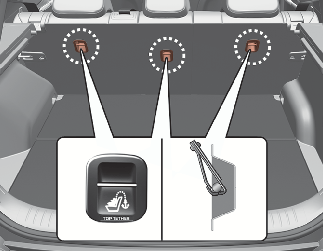
First secure the child restraint with the LATCH lower anchors or the seat belt. If the child restraint manufacturer recommends that the top tether strap be attached, attach and tighten the top tether strap to the top tether strap anchor.
Child restraint hook holders are located on the shelf behind the rear seats.

Take the following precautions when installing the tether strap:
-
Read and follow all installation instructions provided with your Child Restraint System.
-
NEVER attach more than one child restraint to a single tether anchor. This could cause the anchor or attachment to come loose or break.
-
Do not attach the tether strap to anything other than the correct tether anchor. It may not work properly if attached to something else.
-
Do not use the tether anchors for adult seat belts or harnesses, or for attaching other items or equipment to the vehicle.
-
Always fasten the seat belts behind the child restraint seat when they are not used to secure the child seat. Failure to do so may result in child strangulation.
To install the tether anchor:
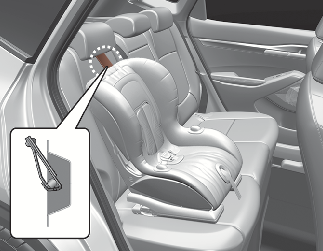
Securing a child restraint with a lap/shoulder belt
When not using the LATCH system, all child restraints must be secured to a vehicle rear seat with the lap part of a lap/shoulder belt.

All passenger seat belts move freely under normal conditions and only lock under extreme or emergency conditions (emergency locking mode). So, in order to secure a child restraint, you must manually pull the seat belt all the way out to shift the retractor to the "automatic locking" mode.
The "automatic locking" mode will help prevent the normal movement of the child in the vehicle from causing the seat belt to loosen and compromise the CRS.
To install a CRS on the rear seats, do the following:
Be sure the seat belt webbing is not twisted.
Position the release button so that it is easy to access in case of an emergency.
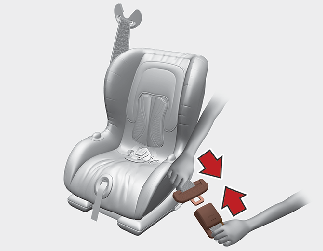
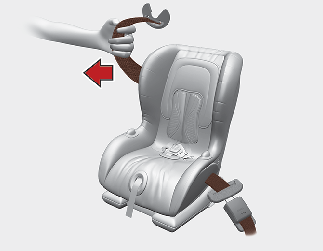
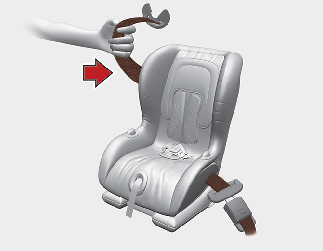
If your CRS manufacturer instructs or recommends you to use a tether anchor with the lap/shoulder belt, refer to More Details for more information.

When the seat belt is allowed to retract to its fully stowed position, the retractor will automatically switch from the "automatic locking" mode to the emergency lock mode for normal adult usage.

Auto lock mode
Set the retractor to Automatic Lock mode when installing any Child Restraint System. If the retractor is not in the automatic locking mode, the child restraint can move when your vehicle turns or stops suddenly. A child can be seriously injured or killed if the child restraint is not properly anchored in the car.
To remove the child restraint, press the release button on the buckle and then pull the lap/shoulder belt out of the restraint and allow the seat belt to retract fully.